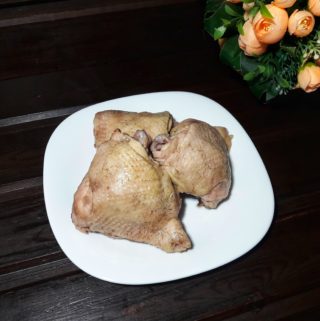
How to Boil Chicken Thighs (Short Summary)
To boil chicken thighs, put 2.5 L water into a pot and boil it, add chicken and aromatics, then boil for another 25 to 30 minutes. Take off the heat and let sit in hot water for another 15 minutes, or until chicken is done.
Ingredients
- 2.5 L filtered water
- 1 kg chicken thighs
- 1 onion
- 1 carrot
- 2 bay leaves
- ½ tsp black peppercorns
- 1 tbsp salt
Instructions
- Put 2.5 L water into a large pot
- Make sure the pot has a lid
- Once it boils, take it off the heat.
- Add 1 kg chicken thighs, or about 4 thighs
- Add 1 onion
- Add 1 carrot
- Add two bay leaves for more flavor
- Add 1/2 teaspoon black peppercorns
- Add 1 tbsp salt
- Put it back on the burner and boil for 25 to 30 minutes
- Remove the chicken - which should be pale in color, and can be easily shaved with a fork
- Take out the chicken using a slotted spoon
Notes
Useful Tips:
- Make sure the chicken thighs are relatively uniformed in size before you start cooking. This shouldn’t be an issue if you’re cooking the chicken from the same package, but different chickens from various farmers or stores tend to vary greatly in size. In particular, organic chickens are often quite a bit smaller than the chicken that are given hormones.
- This recipe is for thawed chicken - if your chicken is frozen, gently thaw it in the refrigerator if you have time, or in a bath of warm water if you need to thaw it quickly. You can also thaw chicken in the microwave using a low setting.
- Don’t give cooked chicken bones to pets! Even if you have cooked it very carefully, cooked bones are more brittle than raw bones and can pose a danger to dogs and cats - their systems are designed for raw animal bones.
- If you have a meat thermometer and want to check the internal temperature, make sure the end of the thermometer is resting against the meat and not the bone to get a more accurate reading.